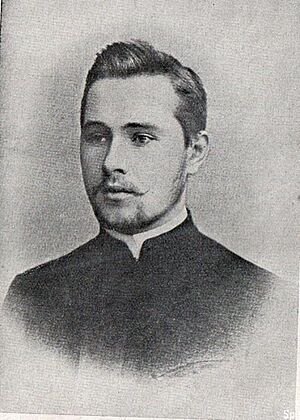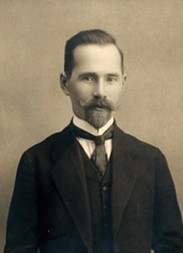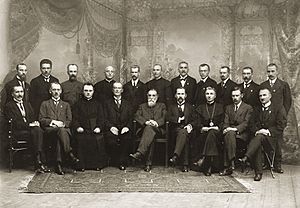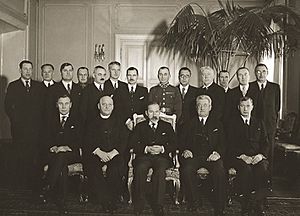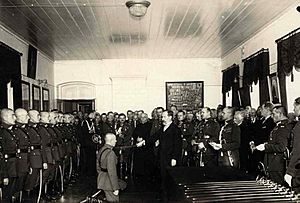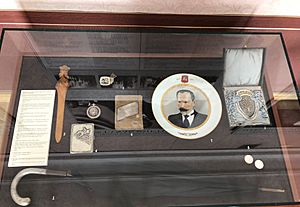Antanas Smetona facts for kids
Quick facts for kids
Antanas Smetona
|
|
|---|---|
 |
|
| 1st President of Lithuania | |
| In office 19 December 1926 – 15 June 1940 |
|
| Prime Minister | Augustinas Voldemaras Juozas Tūbelis Vladas Mironas Jonas Černius Antanas Merkys |
| Preceded by | Aleksandras Stulginskis (Acting) |
| Succeeded by | Antanas Merkys (Acting, de facto)
Vytautas Landsbergis (in 1990, as Chairman of the Supreme Council after restoration of independence) |
| In office 4 April 1919 – 19 June 1920 |
|
| Prime Minister | Pranas Dovydaitis Mykolas Sleževičius Ernestas Galvanauskas |
| Succeeded by | Aleksandras Stulginskis |
| Personal details | |
| Born | 10 August 1874 Užulėnis, Kovno Governorate, Russian Empire |
| Died | 9 January 1944 (aged 69) Cleveland, Ohio, U.S. |
| Resting place | All Souls Cemetery, Chardon, Ohio |
| Political party | Lithuanian Democratic Party (1902–1907) Party of National Progress (before 1924) Lithuanian Nationalist Union (1924–1940) |
| Spouse | Sofija Chodakauskaitė-Smetonienė (1885–1968) |
| Children | Marija Danutė (1905–1992) Birutė (1906–1909) Julius Rimgaudas (1913–1974) |
| Alma mater | University of Saint Petersburg |
| Signature | |
Antanas Smetona (born August 10, 1874 – died January 9, 1944) was an important Lithuanian thinker and writer. He was the first President of Lithuania. He served from 1919 to 1920, and again from 1926 to 1940. He was a key figure in Lithuanian politics between World War I and World War II. He also helped shape the idea of nationalism in Lithuania.
Contents
Early Life and Education
Smetona was born in 1874 in a village called Užulėnis. His family were farmers who used to be serfs, meaning they were tied to the land. His parents worked hard and even doubled the size of their farm. Smetona learned to read at home because his father could read.
When Smetona was 11, his father passed away. Despite money problems, Smetona was sent to primary school. This was his father's last wish. His mother hoped he would become a priest. After primary school, he wanted to continue his education. He had to study privately to catch up.
In 1891, he tried to join a school in Liepāja but was refused. Instead, he went to the Palanga Pre-Gymnasium. This school had no age limits. Smetona was a great student and got free tuition. He also got free housing and earned money by giving lessons. Other future signers of Lithuania's independence also went to this school. Since Palanga was near East Prussia, it was easier to get Lithuanian books. These books were banned by the Russian rulers at the time. Smetona started reading Lithuanian writings and history books.
After graduating in 1893, Smetona joined the Jelgava Gymnasium in Latvia. This school was a center for the Lithuanian National Revival. Many future Lithuanian leaders studied there. A teacher named Jonas Jablonskis helped promote Lithuanian language and culture. Smetona became close with Jablonskis. He also met his future wife, Sofija Chodakauskaitė, through Jablonskis.
In 1896, Smetona and other Lithuanian students were forced to pray in Russian. They refused and were expelled. Smetona and two others managed to speak to a government minister. This led to Lithuanians being allowed to pray in Latin. Smetona then finished his schooling in Saint Petersburg.
In 1897, Smetona started studying law at the University of Saint Petersburg. He was more interested in history and languages. He joined a secret Lithuanian student group. He was briefly expelled and jailed for joining student protests in 1899. This was his first visit to Vilnius, Lithuania's historical capital, which impressed him greatly.
Smetona also helped create a Lithuanian grammar book. This book was very important for setting the standard Lithuanian language. In 1902, police found banned Lithuanian books in his room. He was jailed but later found innocent and graduated.
Early Activities
After graduating in 1902, Smetona moved to Vilnius. He worked at a bank until 1915. He became very active in Lithuanian culture. He spent a lot of time working with Lithuanian newspapers. In 1904, he married Sofija Chodakauskaitė in Vilnius.
Smetona joined various Lithuanian nationalist groups. He became a member of the Lithuanian Democratic Party. He also worked for newspapers like Vilniaus žinios and Lietuvos ūkininkas. In 1907, he helped start a newspaper called Viltis (The Hope). In Viltis, he encouraged Lithuanians to unite. He also helped publish Lithuanian books and taught the Lithuanian language in schools. In 1914, he started a new magazine called Vairas (The Rudder).
Politics
During World War I, Smetona helped Lithuanians who were suffering from the war. In 1916, he and other Lithuanians asked Germany for an independent Lithuanian state. In 1917, he started publishing the newspaper Lietuvos Aidas (Lithuania's Echo). In its first issue, he wrote that Lithuania's main goal was to become an independent state again.
From 1917 to 1919, he was the chairman of the Council of Lithuania. On February 16, 1918, Antanas Smetona signed the Act of Independence of Lithuania. This was a very important moment for the country.
From late 1918 to early 1919, he traveled to Germany and Scandinavian countries. He was trying to get money to help Lithuania become independent. On April 4, 1919, the State Council of Lithuania chose Smetona as the first president. But in 1920, the Constituent Assembly of Lithuania elected Aleksandras Stulginskis as president instead. After this, Smetona edited several newspapers from 1921 to 1924.
In 1923, after the Klaipėda Revolt, he was made a commissioner in the Memelland region. But he resigned due to disagreements with the Prime Minister. In 1923, Smetona was briefly jailed for publishing an article. From 1923 to 1927, he was a professor at the University of Lithuania. He taught about ethics, philosophy, and Lithuanian language. In 1932, he received an honorary Ph.D. degree.
Smetona was also active in the Lithuanian Riflemen's Union. This group helped him become more well-known. He was also the vice-chairman of the International Bank's board for many years.
Authoritarian President
Smetona was one of the leaders of the 1926 Lithuanian coup d'état. This event removed President Kazys Grinius from power. Smetona became president again on December 19, 1926. He appointed Augustinas Voldemaras as prime minister. A year later, Smetona took more control. He created a new constitution in 1928 that gave the president more power. In 1929, he removed Voldemaras and became a dictator.
For the next nine years, Smetona ruled without a parliament. He was re-elected president in 1931 and 1938. Both times, he was the only candidate. The parliament, called the Seimas, did not meet again until 1936. Even then, it was made up only of people who supported Smetona. In 1938, a third constitution was made. It said that political power in the state could not be divided. He stayed in office until June 15, 1940.
As a nationalist leader, Smetona's government closed many Polish-language schools. His government also arrested members of the Communist Party. They said these groups were a threat to the country.
In 1935, farmers in southeast Lithuania went on strike. They refused to sell their products. This led to some deaths and many arrests. This caused problems between those in his government who wanted stricter control and those who wanted more freedom.
However, a bigger threat was growing from Nazi Germany. Smetona's government was the first in Europe to put Nazis on trial. This happened in 1934 in the Memel region, which was part of Lithuania. The trials led to many Nazis being jailed. But by 1938, the Memel region became a difficult issue. Smetona eventually gave Memel to Hitler in 1939. This made him less popular, and he brought opposition members into his government.
Smetona's government was careful about building new factories. This was because his main supporters were farmers. He also did not encourage much foreign investment. However, Lithuania's economy still grew during his time as leader. Factories produced twice as much as before. The country's transportation system also improved with new railways. Smetona's government gave more support to farming. Farming was important because it provided almost all of Lithuania's exports.
Soviet Occupation
In 1940, Soviet troops took over Lithuania. This happened because of a secret agreement between Nazi Germany and the Soviet Union called the Molotov–Ribbentrop Pact. When the Soviet Union demanded control of Lithuania in June 1940, Smetona wanted to fight back. But most of his government and army leaders disagreed. They believed Lithuania could not fight the Soviets effectively.
On June 15, Smetona handed over his presidential duties to Prime Minister Antanas Merkys. Before leaving the Presidential Palace, Smetona said he did not want to turn Lithuania into a Soviet country himself. He believed that by leaving, he could help Lithuania more by leading a government in exile. He first went to Germany with his family, then to Switzerland.
A day after Smetona left, Merkys announced he was the new president. Two days later, Merkys was pressured to resign. Justas Paleckis became the acting president. He was used by the Soviets to help Lithuania become part of the Soviet Union.
Since Lithuania became independent from the Soviet Union in 1990, it has said that Merkys becoming president was illegal. Lithuanian officials do not recognize Merkys or Paleckis as true presidents. They believe all actions that led to the Soviet takeover were invalid.
Flight Abroad
On the morning of June 15, 1940, Smetona quickly prepared to leave Lithuania. He was with his wife, children, and other close people. They stopped at the border with Nazi Germany. Smetona tried to get soldiers to protect them, but it didn't work. Smetona decided to cross the border right away. He and his bodyguard crossed a shallow stream. His family managed to convince border guards to let them through later.
In Germany, Smetona was met by a Gestapo officer. The refugees were taken to a hunting lodge. Later, Smetona was allowed to move to Berlin. There, he was watched closely and could only talk to a Lithuanian representative. The Germans did not let him make any political moves. This was to avoid upsetting the Soviet Union.
On September 4, Smetona asked for U.S. visas. He was given them, but with a condition. He could not be seen as a leader of any state while in the U.S. Smetona accepted this and went to Bern, Switzerland.
In Bern, Smetona met with Lithuanian diplomats. They hoped to create a government-in-exile. Smetona signed a document called the Kybartai Act. This document said that Antanas Merkys was dismissed. It appointed Stasys Lozoraitis as both prime minister and acting president. But this document was never actually used.
Smetona left Bern for Lisbon in January 1941. He then traveled to Brazil and met with the Brazilian president. Finally, on March 9 or 10, 1941, Smetona and his wife arrived in New York. He was greeted by many journalists and Lithuanian-Americans.
They lived for a short time at the Lithuanian Embassy in Washington, D.C. But their relationship with the representative there was difficult. Smetona then lived in Pittsburgh and Chicago. In May 1942, he settled in Cleveland, Ohio with his son's family. While in exile, he started writing a history of Lithuania and his own memories.
Death and Burial
Smetona was busy writing. He did not notice that the heating system in his son's house needed repair. On January 9, 1944, a fire started in the house. Smetona and his wife, Sofija, saw smoke. Sofija went downstairs, but Smetona went back to get a fur coat. He was recovering from the flu and was going to give a speech soon. He was quickly overcome by smoke. His son tried to save him but could not. Smetona was found on the kitchen floor. He was not burned.
Firefighters took Smetona outside. He was rushed to the hospital but died before arriving. The official report said the fire was caused by an overheated furnace. Some people thought the fire was started by the Russian Intelligence Service. But there has been no evidence to support this idea.
On January 13, 1944, Smetona's funeral was held in Cleveland. He was buried at Calvary Cemetery. His wife, Sofija, died in Cleveland in 1968.
They were survived by their daughter, Marija Danutė, and their son, Julius Rimgaudas. Julius had three sons: Anthony Algirdas, Juozas, and Vytautas Julius. In 1975, Smetona's remains were moved to All Souls Cemetery in Chardon, Ohio. He was buried next to his wife, Sofija.
See Also
 In Spanish: Antanas Smetona para niños
In Spanish: Antanas Smetona para niños
- List of Lithuanian rulers
- Konstantin Päts
- Kārlis Ulmanis
- European interwar dictatorships


